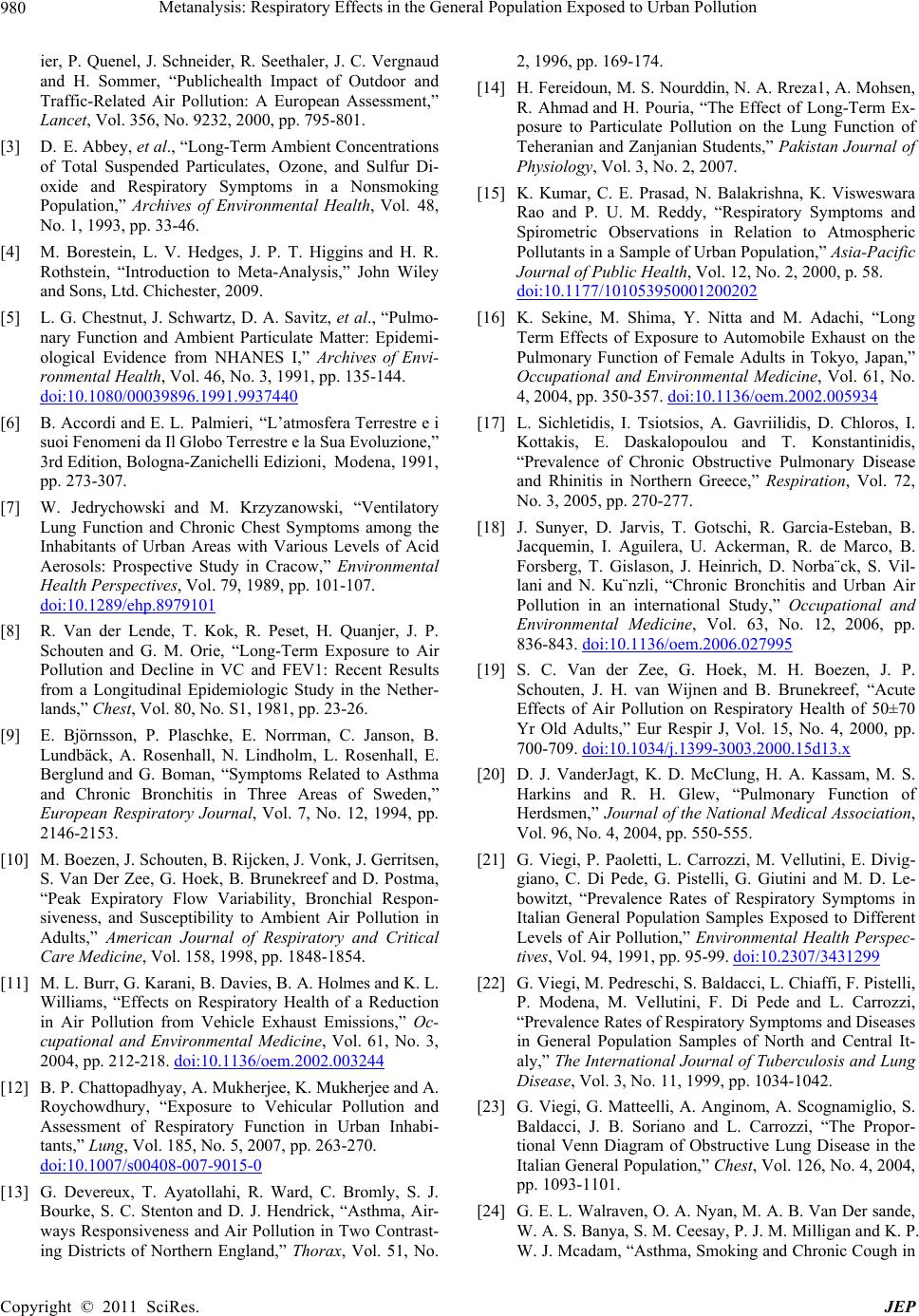
Metanalysis: Respiratory Effects in the General Population Exposed to Urban Pollution
980
ier, P. Quenel, J. Schneider, R. Seethaler, J. C. Vergnaud
and H. Sommer, “Publichealth Impact of Outdoor and
Traffic-Related Air Pollution: A European Assessment,”
Lancet, Vol. 356, No. 9232, 2000, pp. 795-801.
[3] D. E. Abbey, et al., “Long-Term Ambient Concentrations
of Total Suspended Particulates, Ozone, and Sulfur Di-
oxide and Respiratory Symptoms in a Nonsmoking
Population,” Archives of Environmental Health, Vol. 48,
No. 1, 1993, pp. 33-46.
[4] M. Borestein, L. V. Hedges, J. P. T. Higgins and H. R.
Rothstein, “Introduction to Meta-Analysis,” John Wiley
and Sons, Ltd. Chichester, 2009.
[5] L. G. Chestnut, J. Schwartz, D. A. Savitz, et al ., “Pulmo-
nary Function and Ambient Particulate Matter: Epidemi-
ological Evidence from NHANES I,” Archives of Envi-
ronmental Health, Vol. 46, No. 3, 1991, pp. 135-144.
doi:10.1080/00039896.1991.9937440
[6] B. Accordi and E. L. Palmieri, “L’atmosfera Terrestre e i
suoi Fenomeni da Il Globo Terrestre e la Sua Evoluzione,”
3rd Edition, Bologna-Zanichelli Edizioni, Modena, 1991,
pp. 273-307.
[7] W. Jedrychowski and M. Krzyzanowski, “Ventilatory
Lung Function and Chronic Chest Symptoms among the
Inhabitants of Urban Areas with Various Levels of Acid
Aerosols: Prospective Study in Cracow,” Environmental
Health Perspectives, Vol. 79, 1989, pp. 101-107.
doi:10.1289/ehp.8979101
[8] R. Van der Lende, T. Kok, R. Peset, H. Quanjer, J. P.
Schouten and G. M. Orie, “Long-Term Exposure to Air
Pollution and Decline in VC and FEV1: Recent Results
from a Longitudinal Epidemiologic Study in the Nether-
lands,” Chest, Vol. 80, No. S1, 1981, pp. 23-26.
[9] E. Björnsson, P. Plaschke, E. Norrman, C. Janson, B.
Lundbäck, A. Rosenhall, N. Lindholm, L. Rosenhall, E.
Berglund and G. Boman, “Symptoms Related to Asthma
and Chronic Bronchitis in Three Areas of Sweden,”
European Respiratory Journal, Vol. 7, No. 12, 1994, pp.
2146-2153.
[10] M. Boezen, J. Schouten, B. Rijcken, J. Vonk, J. Gerritsen,
S. Van Der Zee, G. Hoek, B. Brunekreef and D. Postma,
“Peak Expiratory Flow Variability, Bronchial Respon-
siveness, and Susceptibility to Ambient Air Pollution in
Adults,” American Journal of Respiratory and Critical
Care Medicine, Vol. 158, 1998, pp. 1848-1854.
[11] M. L. Burr, G. Karani, B. Davies, B. A. Holmes and K. L.
Williams, “Effects on Respiratory Health of a Reduction
in Air Pollution from Vehicle Exhaust Emissions,” Oc-
cupational and Environmental Medicine, Vol. 61, No. 3,
2004, pp. 212-218. doi:10.1136/oem.2002.003244
[12] B. P. Chattopadhyay, A. Mukherjee, K. Mukherjee and A.
Roychowdhury, “Exposure to Vehicular Pollution and
Assessment of Respiratory Function in Urban Inhabi-
tants,” Lung, Vol. 185, No. 5, 2007, pp. 263-270.
doi:10.1007/s00408-007-9015-0
[13] G. Devereux, T. Ayatollahi, R. Ward, C. Bromly, S. J.
Bourke, S. C. Stenton and D. J. Hendrick, “Asthma, Air-
ways Responsiveness and Air Pollution in Two Contrast-
ing Districts of Northern England,” Thorax, Vol. 51, No.
2, 1996, pp. 169-174.
[14] H. Fereidoun, M. S. Nourddin, N. A. Rreza1, A. Mohsen,
R. Ahmad and H. Pouria, “The Effect of Long-Term Ex-
posure to Particulate Pollution on the Lung Function of
Teheranian and Zanjanian Students,” Pakistan Journal of
Physiology, Vol. 3, No. 2, 2007.
[15] K. Kumar, C. E. Prasad, N. Balakrishna, K. Visweswara
Rao and P. U. M. Reddy, “Respiratory Symptoms and
Spirometric Observations in Relation to Atmospheric
Pollutants in a Sample of Urban Population,” Asia-Pacific
Journal of Public Health, Vol. 12, No. 2, 2000, p. 58.
doi:10.1177/101053950001200202
[16] K. Sekine, M. Shima, Y. Nitta and M. Adachi, “Long
Term Effects of Exposure to Automobile Exhaust on the
Pulmonary Function of Female Adults in Tokyo, Japan,”
Occupational and Environmental Medicine, Vol. 61, No.
4, 2004, pp. 350-357. doi:10.1136/oem.2002.005934
[17] L. Sichletidis, I. Tsiotsios, A. Gavriilidis, D. Chloros, I.
Kottakis, E. Daskalopoulou and T. Konstantinidis,
“Prevalence of Chronic Obstructive Pulmonary Disease
and Rhinitis in Northern Greece,” Respiration, Vol. 72,
No. 3, 2005, pp. 270-277.
[18] J. Sunyer, D. Jarvis, T. Gotschi, R. Garcia-Esteban, B.
Jacquemin, I. Aguilera, U. Ackerman, R. de Marco, B.
Forsberg, T. Gislason, J. Heinrich, D. Norba¨ck, S. Vil-
lani and N. Ku¨nzli, “Chronic Bronchitis and Urban Air
Pollution in an international Study,” Occupational and
Environmental Medicine, Vol. 63, No. 12, 2006, pp.
836-843. doi:10.1136/oem.2006.027995
[19] S. C. Van der Zee, G. Hoek, M. H. Boezen, J. P.
Schouten, J. H. van Wijnen and B. Brunekreef, “Acute
Effects of Air Pollution on Respiratory Health of 50±70
Yr Old Adults,” Eur Respir J, Vol. 15, No. 4, 2000, pp.
700-709. doi:10.1034/j.1399-3003.2000.15d13.x
[20] D. J. VanderJagt, K. D. McClung, H. A. Kassam, M. S.
Harkins and R. H. Glew, “Pulmonary Function of
Herdsmen,” Journal of the National Medical Association,
Vol. 96, No. 4, 2004, pp. 550-555.
[21] G. Viegi, P. Paoletti, L. Carrozzi, M. Vellutini, E. Divig-
giano, C. Di Pede, G. Pistelli, G. Giutini and M. D. Le-
bowitzt, “Prevalence Rates of Respiratory Symptoms in
Italian General Population Samples Exposed to Different
Levels of Air Pollution,” Environmental Health Perspec-
tives, Vol. 94, 1991, pp. 95-99. doi:10.2307/3431299
[22] G. Viegi, M. Pedreschi, S. Baldacci, L. Chiaffi, F. Pistelli,
P. Modena, M. Vellutini, F. Di Pede and L. Carrozzi,
“Prevalence Rates of Respiratory Symptoms and Diseases
in General Population Samples of North and Central It-
aly,” The International Journal of Tuberculosis and Lung
Disease, Vol. 3, No. 11, 1999, pp. 1034-1042.
[23] G. Viegi, G. Matteelli, A. Anginom, A. Scognamiglio, S.
Baldacci, J. B. Soriano and L. Carrozzi, “The Propor-
tional Venn Diagram of Obstructive Lung Disease in the
Italian General Population,” Chest, Vol. 126, No. 4, 2004,
pp. 1093-1101.
[24] G. E. L. Walraven, O. A. Nyan, M. A. B. Van Der sande,
W. A. S. Banya, S. M. Ceesay, P. J. M. Milligan and K. P.
W. J. Mcadam, “Asthma, Smoking and Chronic Cough in
Copyright © 2011 SciRes. JEP